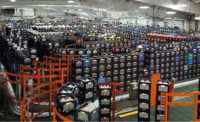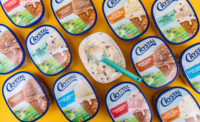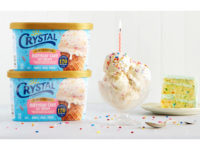Dairy processor Crystal Creamery found itself in need of a branding strategy after acquiring an organic dairy and a conventional dairy. How should it take the two brands to market? Should it merge them or maintain separate identities? Oh, and one more thing -- how should it deal with a change in its corporate name?
Shakespeare’s Juliet mused, “What’s in a name?”
That's the question Foster Farms Dairy might have asked itself. The Modesto-based dairy processor, founded in 1941, knows a thing or two about names and brands. In 2007, it acquired Crystal Creamery of Sacramento, which traces its roots to 1901. Two years later, Foster acquired Fortuna-based Humboldt Creamery, which dates to the 1920s.
From 2009 to 2012, Foster Farms Dairy transitioned to doing business as Crystal Creamery because the Crystal name has more brand equity in the important markets of Sacramento and the San Francisco Bay Area. Foster is keeping the Humboldt name to use on organic dairy products, a segment that is growing.
After growth, a need to focus
Crystal Creamery CEO Frank Otis is the first nonfamily member to head the dairy processing business. But he’s no stranger to the dairy industry, having worked for Nestle, Bongrain, Sodiaal and Dairy Farmers of America. Otis said he wasn’t concerned about stepping into a family business but added that employees might have had their doubts.
“I think it was a concern not so much for me as it was for the employees because they were always used to a Foster being in this chair. When they saw a non-Foster, they thought, ‘Well, what’s his purpose here? Is it to fix it and sell it?’” Otis said.
The purpose most definitely was not to sell it. Otis, who has been CEO for four years, said his first order of business was to establish a focus for the company, which had expanded through acquisitions.
“They had all this growth occurring in the mid- to late-2000s,” Otis said. “The previous management group had made some smart acquisitions. When I got here, there were a lot of opportunities but the simple fact was that the company had to reset and focus on the core business that made Foster Farms Dairy successful for over six decades. The [Foster] family has been fantastic. They were extremely open-minded and let the management team make the necessary changes.”
The business grew from about 600 employees in the early 2000s to as many as 1,300 as late as 2011. The company ranks No. 47 on the most recent Dairy 100, this magazine’s annual list of North America’s largest dairy processors. Crystal Creamery reported 2014 sales of $620 million and 2013 sales of $540 million.
The Foster family’s dairy farms supply about 20% of Crystal’s milk needs. (In the western states, Foster is better known for its chicken processing operations.)
It owns a dairy processing plant in Modesto (next to its corporate headquarters) and in Humboldt, about 300 miles to the northwest. The two plants produce milk, ice cream, butter, cultured dairy foods (except yogurt), milk powders and juices. In addition to the Crystal and Humboldt brands, it owns McColl’s. The company also co-packs products for other dairies and manufactures private label brands. Crystal turns to co-packers to manufacture its single-serve, ultra-pasteurized milk products.
Conventional fluid milk customers include Walmart, McDonald’s and grocery stores, to name a few. Organic fluid customers include Costco stores in the Bay Area. Trader Joe’s and Costco are long-term ice cream partners and customers. The newly developed Humboldt Creamery organic ice cream became available in April at more than 3,200 Walmart and 125 California Safeway stores. Dairy powders (organic and conventional) are bought by food processors and confectioners.
Otis said he has spent a lot of his time over the last 18 months on the organic business. With Walmart placing Humboldt ice cream in freezers in the coming months, “we think we could be a significant player” in organic ice cream, he said. “Ice cream is not a category that organic offerings have expanded, like fluid milk, yogurts or cheeses. We feel that the organic ice cream product category is on the verge of significant growth.”
A two-brand strategy
Maintaining separate brands for conventional (Crystal Creamery) and organic (Humboldt Creamery) offerings reduces confusion with the consumer when they shop the dairy case, Otis said.
“It’s a good separation because we treat them differently (in public relations, advertising and marketing). Clearly, it would be more efficient to just lump everything under one brand. That separation creates challenges, but it also creates a uniqueness of the brand that you wouldn’t get if you tried to tie them both together.”
Crystal is “a very strong brand,” said Vice President of Sales Dennis Roberts. “We continue to try to have a lot of brand awareness campaigns to focus in on that. We want to keep the brand out in front of customers.”
The Crystal brand, once owned by HP Hood, is over 114 years old. It is the No. 2 brand in northern California, Roberts said, but in Sacramento, Crystal is No. 1.
Managing brands is “tricky,” Otis said. “We’re learning. I’m not going to sit here and tell you we’ve perfected this marketing strategy with these two brands. The biggest challenge for our company is going into this value-added sale. It is a different approach.”
“In organic, you’re really selling a story, which I think, makes Humboldt a great brand,” Otis said. “We want to be one of the top fresh (HTST) organic dairy brands in the state of California which relies on extensive DSD distribution capabilities and a locally farmed and processed business model, which is an area of focus for both retailers and consumers.
“With frozen offerings, we’d like to be a national brand with the Humboldt brand. With this offering, we are much more dependent on the retailers taking our products into their own warehouses whenever possible. These two different distribution strategies require different marketing activities and approaches,” Otis said.
Chief Financial Officer Mark Shaw called the company’s focus on organic dairy “really critical to our long-term viability. It’s very hard to have brand equity in just your basic branded milk. Consumers are only going to pay so much over a private label price. But the value-added organic strategy gives us an opportunity to really support the core business.”
Crystal Creamery is investing in equipment to expand the marketing area for organic milk products. It installed an extended shelf-life filler for quarts and smaller sizes in the Modesto plant. A new half-gallon filler with similar capabilities will be installed in Humboldt. That gives the creamery an extra four to six days of shelf-life. Otis emphasized that the milk will be processed in a high-temperature/short-time pasteurizer, not ultra-pasteurized.
“It’s still a fresh product,” he said, but with extended shelf-life, “we can definitely handle the Southern California market with no issue which greatly assists us in attaining our stated goal to be the No. 2 California-based organic dairy brand within the next three years.”
He called organic consumers “pretty sophisticated.” When they see a 65-day shelf-life on a carton of organic milk, they ask questions like: How fresh can this be? Where is this coming from? How local is this? How organic is this? When they see a 20- to 25-day shelf life, they say, “Okay, this is a local product. It’s fresh,” Otis said.
“When they see product with longer shelf-life, sometimes they really have doubts,” he added. “I’m not saying it’s right or wrong, I’m just saying consumers (for organics) are pretty savvy. We think our strategy is always to stay with a fresh product. We’re not going to venture into ultra-pasteurization. (Other companies) do a great job in this area of processing, but that’s not going to be what we do.”
The dairy industry is not without risks. Weather affects dairy farms, consumers’ tastes change, competitors fight for market share and government policies can affect plans. Crystal is using future contracts and hedging strategies to control costs and to secure margins, Shaw said.
Investments that make a difference
As CFO, Shaw is keenly interested in the company’s investments in the dairy farm and processing plants. The company is replacing older equipment, integrating systems and investing in automation, like the boxer/palletizer in Humboldt.
“The Foster family and our board have been extremely patient with us in terms of allowing the turnaround plan that Frank started to come to fruition,” Shaw said. “Now we’re at a point where we can tell them: We’ve turned the business around. We’ve made good money the past two years, and strategically, there are things we need to invest in.”
Another investment has been in sustainability. The sustainability program is run by Human Resources Vice President Luis Miranda. The goal is zero waste to landfill. The company has invested in energy products, such as replacing lighting, optimizing the engine rooms and phasing certain equipment to run on off-peak times. Other initiatives include reusing waste water and reducing the amount that is sent down the drain.
The federal Environmental Protection Agency named Crystal Creamery an innovation winner in the 2015 Food Recovery Challenge for its dairy digester program. The creamery’s waste water pretreatment system removes organic contaminants generated by dairy processing. The organic by-products are sent to a local dairy farm and combined with manure and other wasted food in an anaerobic digester. The digester produces enough electricity to power 38 homes and it creates liquid and solid by-products, which are valuable commodities.
A new nondairy beverage
Developing new products is done in-house with the cooperation of customers and suppliers. Earlier this year, Crystal launched a 5% juice drink at the request of a retail customer, Roberts said. The juices are available in five flavors, including berry, watermelon and tropical punch, in gable-top cartons with spouts.
“A customer came to us and said, ‘Here’s a void. Can you create this for me?’” Roberts said. “Versus some of the national (brands), it’s got less calories and less sugar. And it’s a great-tasting product. That’s what’s fun here. I’ve got somebody that helps us from a new product standpoint. We work with a lot of our stabilizer companies and sweetener companies. But then we put it together and say, ‘This is what we want to do.’”
To find new customers, Crystal exhibits at industry trade shows, such as Natural Products Show West in Anaheim, Calif. In November, for the first time, Crystal Creamery will be exhibiting at the PLMA show (private label) in Rosemont, Ill.
“When you think of Crystal, you think of a small family dairy,” Roberts said. “You don’t think about how much we’re doing (in conventional and organic dairy) and the reach we’re able to do. So I think that’s why it’s important for us to get in front of the PLMA show.”
So what’s in a name? When it comes to Crystal Creamery, the name consists of quality, efficiency and innovation. Whether the brand is Crystal, Humboldt or a private label one, the creamery is proud of its ability to manufacture quality products across the dairy foods spectrum.







